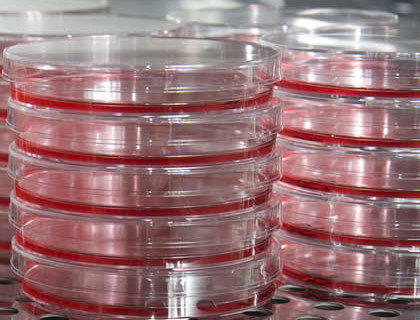
3-D Bioprinting – When cells become ink
I have been peripherally aware of 3-D printing for various industries. I know that architects can use it to create scale models of buildings, the car industry can use it to create part prototypes and prosthetics are even printed for use in healthcare. Although, I may be cell biased, to me the most exciting use for 3-D printers is to print living tissue.
3-D Bioprinting Applications in Development
Researchers have successfully demonstrated that they can use 3-D bioprinters to create living tissue including liver, cartilage, heart, and fat tissue. Organova, a San Diego based company is currently using 3-D bioprinting to produce liver tissue for drug screening and toxicity testing. The process, described on their website, begins with a design of the tissue to be made, then they use bio ink, “multi-cellular building blocks used to build target tissue,” released from a bioprinter in a layer by layer building approach. The company just released data last week demonstrating that their human liver tissue retained key functions for up to 40 days, the next best system in 2-D only retains function for 48 hours. This is important for pharma companies who would like to be able to use liver tissue for drug challenges and need to be able to test various doses in the same tissue over a period of time. Organova plans to launch their product in 2014. Eventually perhaps there will be the capacity for an entire liver to be created using a similar process. For more information on the Organova liver tissue, please see this video [youtube id=s3CiJ26YS_U width=”620″ height=”360″]
Another example of bioprinting was recently featured in the New York Times article titled, “At the printer, living tissue”. In the article Dr. Darryl D’Lima, who heads an orthopedic research lab at the Scripps Research Institute, describes how his group began using modified ink jet printers to print cartilage. He believes cartilage is a good fit for 3-D bioprinting because chondrocytes secrete their own matrix, don’t need many nutrients and overall are pretty low maintenance. Their “bio ink” is made up cartilage cells and PEG-DMA that when printed under UV light has a gel consistency. Of course, this is a very complex process in a completely new area, so there are challenges that must be routinely overcome. In the New York Times piece Dr. D’Lima describes some of the complexities by saying, “Most 3-D printers just change the shape. We are changing the shape, the composition, the type of cells, even the orientation of the cells.”
Wake Forest also has a 3-D bioprinting application that they are working on for burn wounds. They have developed a procedure that takes a scan of a burn wound then the 3-D printer would directly print skin cells onto the burn wound in layers that would replace where the damaged skin had been. Using the scan as a map, the printer can fill in the burn wound until it is covered with the new skin cells. The application is currently in clinical trials in mice.
Challenges
As with any new technology, there are challenges to reaching a therapeutic application. One identified problem is how to keep bioprinted tissues nourished, particularly for transplant cases until the body can build the appropriate blood vessel connections. In some instances, these tissues are kept in well plates or bioreactors to maintain until ready for use. In other instances, tubes have been inserted as artificial blood vessels to provide nutrients until the structures could be incorporated into the body.
There are also the challenges with mechanics of the printer meeting the challenges of living cells. Particularly important are minimal heat to prevent damage to cells, pore size of jet to allow for cells to pass through without clogging and as Dr. D’Lima discusses in the New York Times article, figuring out how to keep the bio ink liquid for printing purposes, then getting it to harden appropriately in order to maintain its shape. In addition there are also challenges with creating new supporting materials to carry the living cells – how do you make a bio ink that addresses the needs of the cells, the needs of the structure, and also meets all necessary safety requirements. Lastly, there is debate about what will be required for Food and Drug Administration acceptance and approval as a therapy. Ultimately it is a long and complex journey for these potential therapies, but clearly an exciting new area of discovery.
Cell Types
Researchers are examining the use of a patient’s own cells, adult stem cells, induced pluripotent stem cells and cord blood cells.
The Future
While everyone would love to see actual transplantable organs generated by 3-D printers, most believe that this is at least 20 years or more in the future. Until then, there are many applications involving living tissue that would benefit patients. In addition to the applications I described above, researchers are working on heart tissue to use as patches for repairing heart damage and fat tissue to repair damage done by breast lumpectomies. These initial technologies are building proof of principle, safety and efficacy which will pave the wave for future uses of this technology – maybe even organs someday!